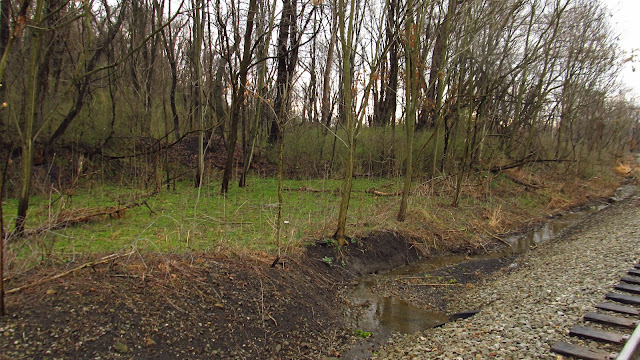Morgan Valley is a section of railroad running between Everson and Broadford. This roughly three mile stretch was part of the Mt. Pleasant Branch of the B&O Railroad and contained eight coke plants and ca. 1907 had 901 ovens burning. This valley literally had to be bright 24 hours a day. I was going off the law of averages and figured there had to be at least something left down here. It turned out decent, but for the amount of ovens that were here it should have been a lot more.
 |
A portion of a 1907 Connellsville Coke Region map. Today we went from Tip Top to Frick. Valley was covered in a previous post, as was Sterling and Tyrone. The problem with this map is the scale is horrendous. Fortunately the mine maps are highly detailed as to the location of the ovens as well as labeling which is which. Also, the number of ovens at each of these plants are going off the 1907 map. It would be safe to assume that 1907 would be the peak for this area and after this there were probably no more ovens added at these plants. These were some early coke plants, many dating back to the 1870's. |
 |
Starting off at Tip Top. I did this section before and only found the smallest remains of any ovens. The ovens would be to the left. |
 |
The whole side of the railroad is lined with old beehive coke in this whole stretch through the Tip Top area. |
 |
The curve in the track to the left indicates the end of the Tip Top plant. I was looking to the left the entire time and came across some remaining ovens from Tip Top. |
 |
This is the furthest I walked and honestly just assumed that there was nothing left. This was a very welcome surprise. |
 |
Tip Top still has some ovens left! |
 |
There is a house nearby and somebody is obviously taking care of what is left. |
 |
Heading up, they do start to disappear. |
 |
Looking up the Tip Top siding. |
 |
Back on the tracks. Next up Franklin Coke Works. |
 |
The old branch that led up to the Franklin Coke Works. |
 |
You could see a few of the remaining ovens on the hillside from the railroad. |
 |
The remaining ovens are in somebody's yard. I knocked on the door and nobody answered. I took a couple pictures and got out of Dodge. |
 |
Believe it or not, B.F. Keister ad Co. built these ovens the whole way back in 1862. We're lucky to have anything left at all. These ovens probably burned until the 1910's as well. |
 |
Moving along. This is heading into Owensdale. The next set of ovens we are looking for are the Summit Coke Works. |
 |
Cruising through Owensdale. |
 |
Leaves are growing on the vegetation already. It's going to be a short coke oven season this year. |
 |
Heading down again. We are looking for the Eagle Coke Works on the right and the White Coke Works on the left. Spoiler alert, the junkyard claimed them all. |
 |
Back on the road. Next we are looking for Foundry Coke Works. |
 |
There were some suspicious looking banks... |
 |
....and then ovens started appearing! |
 |
Finally. |
 |
An old wall along Galley Run, protecting the spur that heads up to the Foundry Coke Works from erosion. |
 |
Where the Foundry spur leaves the tracks. |
 |
Heading back to look at these ovens. |
 |
It's nice to see ovens though. |
 |
Looking up the spur. Probably about where it ended. There is nothing else past here. |
 |
This is a very old coke oven brick. It was later when they started stamping them with the manufacturer. |
 |
There is still some interesting stonework on the hillside next to the railroad. Perhaps the location of an old tipple. |
 |
Pulling down into Broadford. |

Old railroad ties sticking out of the hillside above Broadford Road.

Old buildings belonging to the long abandoned Old Overholt Distillery. Marybeth and me explored this about five years ago and I've been meaning to get back. Here's what we did then.

Walking back to Everson.

Old railroad ties sticking out of the hillside above Broadford Road.

Old buildings belonging to the long abandoned Old Overholt Distillery. Marybeth and me explored this about five years ago and I've been meaning to get back. Here's what we did then.

Walking back to Everson.
 |
Back where I parked at. This old brick house just amazes me for some reason. It's horrible to see it decaying. The roof was intact two years ago. |































